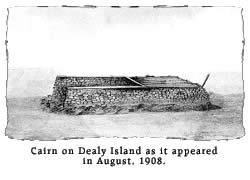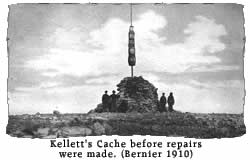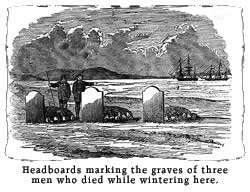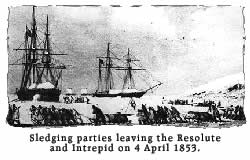|
Northern Vignettes
Arctic Harpoons
Beechey Island
Crystal II
Deline/Fort Franklin
Fort Hope
Fox Moth
Kellet's Storehouse
Naujan
Old Fort Providence
Old Fort Reliance
Stone Church
Thule Village
Yellowknife
Fort Journal
|
Built with one hundred tons of local sandstone, the double walls of the storehouse were filled with sod and roofed with canvas and coal bags, supported by posts. The cache or "Sailors Home" was
Kellett left a plan of the stores in the cache and a message for those who might use it. "This is the house that Jack built ... under especial patronage of my Lords Commissioners of the Admiralty. Here, Royal Sailors and Marines are fed, clothed and receive double pay for inhabiting it." Although the expedition was unsuccessful in locating traces of Franklin's passage, spring sledging parties of 1853 from H.M.S. Resolute and H.M.S. Intrepid located the H.M.S. Investigator under the command of Robert McClure, which had been beset in ice at Mercy Bay on northern Banks Island for the summers of 1851-52, and rescued the crew. Records of the expedition include descriptions of physiography, geology, biology and Inuit customs.
Since the turn of the century many expeditions have visited and used the cache. Members of the Canadian Arctic Expedition of 1913-18, led by Vilhjalmur Stefansson, stopped there in 1917. They removed the roof which hastened the destruction of the storehouse's contents by exposing them to the elements. A patrol of the Royal Canadian Mounted Police in 1929 used meat from the cache to supplement their rations of dog food. The RCMP schooner, St. Roch, commanded by Staff Sergeant Henry Larsen, anchored there in 1944, and ten years later, the island was visited by two icebreakers, the H.M.C.S. Labrador and the U.S.S. Burton Island. "Placed in the arctic by men in wooden sailing vessels, the storehouse retained its usefulness in the age of aircraft and automobiles." (Janes 1982:367) By the mid-1970s, humans and nature had caused serious deterioration to the building and its contents. A team of archaeologists, conservators and architects decided that the best way to ensure the longevity of this heritage resource was to preserve it in place. Artifacts which had been strewn outside the building were removed and conserved and now rest at the Prince of Wales Northern Heritage Centre in Yellowknife. Items in the storehouse were left in place and sealed beneath an insulated floor. The building was repaired and stabilized and the walls reconstructed as closely as possible to the original. These fragile remains were declared a site of territorial historic significance in 1978 under the Historical Resources Act and are protected from any disturbance by the Northwest Territories Archaeological Sites Regulations.. Removing artifacts or altering structures destroys unique information from the past. References Captain J. E. Bernier. Report on the Dominion of Canada Government Expedition to the Arctic Islands and Hudson Strait on Board the D.G.S. "Arctic". Ottawa: Government Printing Bureau. 1910. C. R. Harington. "The Cache on Dealy Island". Canadian Geographical Journal, Volume LXVIII, No. 3, pp. 74- 83. 1964. Robert Janes. "The Preservation and Ethnohistory of a Frozen Historic Site in the Canadian Arctic." Arctic, Volume 35, No. 3, pp. 358-85. 1982. Robert Janes. "A Frozen Glimpse of British Exploration in the Canadian Arctic." In Collected Papers on the Human History of the Northwest Territories edited by M. J. Patterson, C. D. Arnold and R. R. Janes. Occasional Paper No.1 of the Prince of Wales Northern Heritage Centre, Yellowknife, Northwest Territories. 1985. Henry Kellett. Proceedings of Captain Kellett, C.B., H.M. Discovery Ship Resolute. In: Further Papers Relative to the Recent Arctic Expeditions in Search of Sir John Franklin and the Crews of the H.M.S. Erebus and Terror, pp. 69-106. Presented to Both Houses of Parliament by Command of Her Majesty. London: George Edward Eyre and William Spottiswoode. 1852. George Frederick McDougall. The Eventful Voyage of H.M. Discovery Ship "Resolute" to the Arctic Regions in Search of Sir John Franklin and the missing crews of H.M. Discovery Ship "Erebus" and "Terror", 1852, 1853, 1854. London: Longman, Brown, Green, Longmans, and Roberts. 1857. |
 In
1853, the men of a British Navy enterprise under the command of
Captain Henry Kellett, H.M.S. Resolute, and Francis Leopold
McClintock of H.M.S. Intrepid constructed a storehouse on
Dealy Island, off the south coast of Melville Island in the Western
Arctic Archipelago. Kellett and his men were part of the Belcher
Expedition of 1852-54. This was the British Admiralty's final search
for the Northwest Passage Expedition of 1845, led by Sir John Franklin,
which had failed to return to England. Kellett's orders were to
deposit provisions at a cache for expeditions in dire circumstances.
In
1853, the men of a British Navy enterprise under the command of
Captain Henry Kellett, H.M.S. Resolute, and Francis Leopold
McClintock of H.M.S. Intrepid constructed a storehouse on
Dealy Island, off the south coast of Melville Island in the Western
Arctic Archipelago. Kellett and his men were part of the Belcher
Expedition of 1852-54. This was the British Admiralty's final search
for the Northwest Passage Expedition of 1845, led by Sir John Franklin,
which had failed to return to England. Kellett's orders were to
deposit provisions at a cache for expeditions in dire circumstances.
 stocked with a complete inventory of supplies used in mid-19th century
arctic exploration. The provisions, ammunition, and fuel were sufficient
to sustain a party of 66 men on full allowance for 210 days. It
is interesting to note the items used by British explorers at this
time: 123 varieties of food including six tons of flour, over two
tons each of beef and bacon, over a ton each of sugar, preserved
meats, vegetables and potatoes, and 600 pounds of Normandy pippins
(dried apples) for dessert. Clothing deposited at the storehouse
included 66 pea-jackets, 108 sets of woollen underwear, 129 pairs
of boots and 143 pairs of mitts. Two Hudson Bay muskets and ammunition,
an inflatable "Halkett" boat, medical supplies and instruments,
and a Union Jack were also placed in the storehouse.
stocked with a complete inventory of supplies used in mid-19th century
arctic exploration. The provisions, ammunition, and fuel were sufficient
to sustain a party of 66 men on full allowance for 210 days. It
is interesting to note the items used by British explorers at this
time: 123 varieties of food including six tons of flour, over two
tons each of beef and bacon, over a ton each of sugar, preserved
meats, vegetables and potatoes, and 600 pounds of Normandy pippins
(dried apples) for dessert. Clothing deposited at the storehouse
included 66 pea-jackets, 108 sets of woollen underwear, 129 pairs
of boots and 143 pairs of mitts. Two Hudson Bay muskets and ammunition,
an inflatable "Halkett" boat, medical supplies and instruments,
and a Union Jack were also placed in the storehouse.  Also remaining from Kellett's expedition are a large cairn on the
island's summit, the graves of three men, and two sledges and an
abandoned whale boat of the H.M.S Resolute
Also remaining from Kellett's expedition are a large cairn on the
island's summit, the graves of three men, and two sledges and an
abandoned whale boat of the H.M.S Resolute Captain J. E. Bernier of the D.G.S. Arctic visited the storehouse
in 1908, while on a voyage to establish Canada's sovereignty over
the Arctic Islands. He found that many of the provisions were well-preserved.
He repaired the roof of the structure, and replaced decaying items
with new ones. The two useless muskets were substituted with two
Ross rifles and 1000 rounds of ammunition; the muskets as well as
the two sledges left by Kellett were given to the National Museum
of Man. Bernier's men also carved a message on a rock near the storehouse.
Captain J. E. Bernier of the D.G.S. Arctic visited the storehouse
in 1908, while on a voyage to establish Canada's sovereignty over
the Arctic Islands. He found that many of the provisions were well-preserved.
He repaired the roof of the structure, and replaced decaying items
with new ones. The two useless muskets were substituted with two
Ross rifles and 1000 rounds of ammunition; the muskets as well as
the two sledges left by Kellett were given to the National Museum
of Man. Bernier's men also carved a message on a rock near the storehouse.